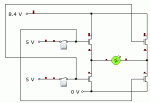calvinsykes
Member
You can't do it easily, I know. But unless anyone knows of a TO-220 packaged P-Channel that can pass 10A, it's the only solution I have.
The application is essentially to make a giant L293D bi-directional motor controller. The FETs I have available are IRF530s. They have a threshold voltage of 2.4V and are driven by 5V from a PICAXE. They are switching a voltage of between 6 and 8.4V.
So, for the low-sided ones, no problem. But the high sided ones barely turn on at all. I breadboarded it and the motor barely spun while the high-side FET got pretty toasty. Some solutions I thought of are as follows:
Circuit schematic shows the general idea.
Which way is best?
The application is essentially to make a giant L293D bi-directional motor controller. The FETs I have available are IRF530s. They have a threshold voltage of 2.4V and are driven by 5V from a PICAXE. They are switching a voltage of between 6 and 8.4V.
So, for the low-sided ones, no problem. But the high sided ones barely turn on at all. I breadboarded it and the motor barely spun while the high-side FET got pretty toasty. Some solutions I thought of are as follows:
- Massive great 20W resistor on high side of high-side FET to bring voltage down to a low level, but then there'll be practically nothing to drive the motor.
- Charge pump to double 5V to 10V.
- Create a second rail by paralleling two*AA batts with main battery, use PICAXE to switch this, which then switches the FET.
- Don't bother and try and find a beefy enough P-Channel device
Circuit schematic shows the general idea.
Which way is best?
Attachments
-
3.8 KB Views: 52

